By Capt. Cefus McRae, Nuts & Bolts of Fishing Series

I love fly fishing. I’m not the best long-pole thrower on the planet, but I can usually make a cast that gets the fly in the general vicinity. One thing I’m continually amazed by, especially when trout fishing, is how small those dang flies are, and just how big the fish are that I’ve caught with such a tiny fly. I mean, some of the flies are almost too small to see or to tie on the end of a leader.
One thing I’ve learned from fly fishing which I’ve carried over to conventional fishing techniques is an understanding of hook size, and the fact you don’t necessarily need a hook made from rebar to catch a big fish. The biggest rainbow trout I ever caught was over seven pounds, and I caught it with a fly tied to a #18 size hook. By the way, a #18 hook is small, really small.
I believe a mistake many anglers make is using hooks that are too big. They think you need a big hook to catch a big fish. In some cases, that’s true. Strong fish require a strong hook that won’t straighten out under pressure. But more often, it’s the gap of the hook that you really need to be focused on.
Hooks come in a variety of configurations, shapes, sizes and materials. My rule of thumb is to always use the smallest, lightest hook I can get away with. That rule of thumb is guided by the size of the bait that I’m using, not the size of the fish I’m fishing for. Usually, the two will go hand-in-hand. A hook used to fish for bream with a cricket is going to be much smaller than a hook used to troll for marlin with a 3 pound Spanish mackerel. The more you can conceal the hook from your quarry, the more likely they are to eat the bait attached to it. A hook size properly matched to the bait you’re using will let allow that bait to move more naturally, and keep them frisky longer too.
Nowadays, I use circle hooks almost all the time. Once you get used to the hook-up technique, you’ll find you actually have a better success rate. And if you are in the catch-and-release mode, fish have a much better chance for survival after the release.
For circle hooks I like the Gamakatsu Nautilus Light circle hook. It comes in a variety of sizes from small enough for mud minnows and fiddler crabs and to big hooks for full grown mullet. Even though it’s a relatively light wire hook, it’s strong enough to handle big fish. The shorter shank means there’s less ‘hook’ exposed that might shy fish away.
While we’re on hook styles, I love to throw soft plastics. Many worms, flukes and paddletails need a little help getting down into the strike zone. Carolina rigs, Texas rigs and jig heads will serve the purpose, but sometimes you need to be super-stealthy. All that weight in front of the plastic can spook fish or get hung up on grass, brush and rocks. Years ago I discovered the advantages of what I call the “Flutter Hook”. In reality, it’s a weighted-shank, worm hook. The Gamakastu EWG (extra wide gap) Weighted Monster hook offers a big gap, sizes to match even the biggest plastic swim baits, and you rig it weedless. The weighted shank gets the lure into the strike zone quicker too. On the fall, the lure ‘flutters’ down like a distressed minnow, and as you retrieve the weight imparts a lot more action that a non-weighted worm hook might create. I’ve used this hook for everything from soft plastics to cut bait, and it’s become my go-to hook for inshore fishing. Again, I match the size of the hook to the size of the bait I’m pitching.
There’s an axiom that states, “Elephants eat peanuts”. I think that’s true for fish too. Fish don’t necessarily eat peanuts, but big fish will often focus on very small prey. I’ve seen 25 pound stripers crashing baitfish that were an inch long, and I’ve seen 40 pound amberjack gulping 3 inch glass minnows. The only way to catch those fish was with similar-sized baits, and that meant sizing all the terminal tackle down to match.
The next time you rig up, take a moment to consider your quarry. Also consider what your bait or lure looks like to the fish you hope will eat it. Does it look and move naturally? Or is it hampered by a hook that’s too big? Try sizing down and be prepared to reap the rewards of the big fish you’ll catch.
Tight lines and calm seas!
